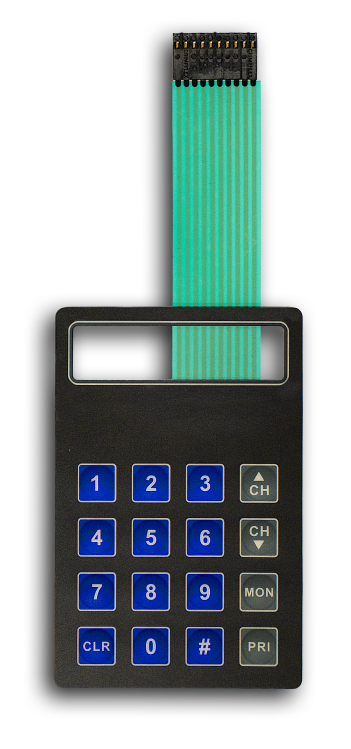Understanding the Relevance of Membrane Switches in Individual User Interfaces
Membrane buttons are important components in the style of effective individual interfaces, facilitating not just functionality yet also boosting aesthetic charm and customer interaction. Their one-of-a-kind functions, such as resistance to ecological elements and personalized designs, make them suitable for a diverse selection of applications across several sectors. As we explore the different benefits and future fads connected with Membrane technology, it ends up being clear that these buttons are more than just parts; they stand for a convergence of advancement and usefulness. The implications of this technology on individual experience deserve checking out further.
What Are Membrane Buttons?

The spacer layer, which includes sticky residential properties, enables for the separation of the circuit layer from the overlay, guaranteeing that the switch remains in a non-activated state until pressed. When pressure is related to the overlay, it compresses the spacer layer, bridging the space and completing the circuit in the underlying layer. This style not only decreases the physical space needed for traditional mechanical buttons but additionally enhances the toughness of the gadget, as Membrane buttons are typically resistant to dirt, dampness, and various other ecological elements.
Commonly located in applications ranging from consumer electronic devices to medical tools, Membrane buttons are essential to contemporary technology, providing a easy to use and effective user interface that lines up with modern design needs.
Advantages of Membrane Buttons
While numerous button technologies exist, Membrane Switches deal distinctive benefits that make them specifically preferable in numerous applications. Among the key advantages of Membrane buttons is their small layout, which enables space-saving executions in devices where real estate is restricted. Their thin profile not just improves visual appeal but also helps with light-weight construction.
An additional substantial advantage is their resistance to ecological factors. Membrane buttons are typically secured against moisture, dust, and impurities, making them ideal for usage sought after environments, such as medical gadgets and commercial tools. This sturdiness prolongs the life expectancy of the switch, lowering maintenance costs and improving dependability.
Additionally, Membrane buttons can be tailored to fulfill details layout requirements, incorporating unique graphics and colors that enhance user interaction. Their responsive responses alternatives can additionally be customized to give an enjoyable customer experience. In addition, Membrane switches are affordable, especially in high-volume applications, as they can be produced efficiently.
Applications in Various Industries

In the consumer electronic devices industry, Membrane switches prevail in tools such as microwaves, washing equipments, and push-button controls. Their responsive comments and aesthetic choices enhance individual experience while providing a smooth, modern appearance. Additionally, vehicle manufacturers use Membrane switches in control panel controls and infotainment systems, where area is limited, and individual involvement is vital.
Moreover, the industrial field leverages Membrane switches in control panels for equipment and equipment, enabling instinctive operation in commonly harsh atmospheres. Their resistance to chemicals and dampness see post guarantees durability and integrity in these applications. In general, the versatility of Membrane Switches contributes significantly to their prevalent use, making them essential in different technical domains.
Style Factors To Consider for Membrane Switches

When creating Membrane buttons, numerous vital considerations must be taken into account to make sure ideal performance and customer experience. To start with, the selection of products is critical; selecting durable, top quality substrates can improve the switch's longevity and resistance to environmental factors such as moisture and temperature fluctuations.
Secondly, the design of the graphic overlay need to focus on clearness and ease of use. Symbols and message should be clear, and the layout needs to assist in user-friendly interaction (membrane switches). In addition, responsive feedback is essential; including a responsive dome or other devices can improve the user experience by providing physical verification of her comment is here activation
Another important aspect is the switch's electric performance. Designers need to guarantee that the conductive traces are properly created to reduce resistance and stay clear of signal disturbance. This involves examining the required actuation pressure and guaranteeing compatibility with the digital elements they will certainly interface with.

Future Fads in Membrane Innovation
As modern technology remains to breakthrough, Membrane switches are positioned to evolve substantially, driven by innovations in materials and making techniques. One emerging fad is the incorporation of sophisticated products, such as conductive inks and flexible substrates, which enhance sturdiness and lower the overall weight of Membrane switches. These materials not just improve the tactile action yet also enable for the style of buttons that can hold up against harsher environmental conditions.
Moreover, the assimilation of touch-sensitive modern technologies is changing traditional Membrane Switches into more interactive interface. Capacitive touch sensors embedded within Membrane switch panels can supply an extra instinctive and receptive customer experience, aligning with the expanding need for streamlined, modern designs in consumer electronic devices.
Additionally, advancements in printing techniques, such as electronic and 3D printing, enable quick prototyping and modification of Membrane buttons. This versatility enables makers to respond much more rapidly to market demands and consumer choices.
Last but not least, sustainability is coming to be a considerable focus, with producers exploring environmentally friendly materials and processes. As these fads unravel, the future of Membrane technology assures boosted performance, aesthetic allure, and ecological obligation, solidifying their duty in innovative individual interfaces across different sectors.
Final Thought
In final thought, Membrane Switches stand for a vital element in the layout of user interfaces, integrating functionality with aesthetic adaptability. As advancements in innovation proceed, the evolution of Membrane buttons is anticipated to further fine-tune customer interfaces, driving innovation and enhancing use in an increasingly complicated technical landscape.
Membrane buttons are integral elements in the style of reliable user interfaces, helping with not only capability yet also enhancing aesthetic charm and individual communication.Membrane Switches offer as a vital component in different individual interfaces, assisting in a smooth communication in between customers and digital devices.While numerous switch innovations exist, Membrane Switches offer distinct advantages that make them especially desirable in different applications.Additionally, Membrane switches can be personalized to satisfy particular style demands, integrating distinct graphics and colors that enhance user interaction.In conclusion, Membrane Switches stand for a crucial element in the style of user interfaces, combining functionality with visual adaptability.